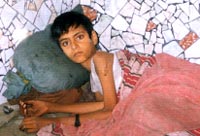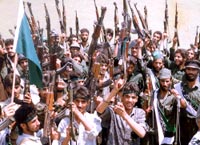
The Kashmir conflict, which killed at least 35,000 people since 1989, has sired a generation of children lost to hate and fear. They grow up in the no man's land between politics and war. This series focuses on them, the children of an unfortunate conflict.
By CHINDU SREEDHARAN
|
• About This Series • Page 1 • Page 2 • Page 3 • Page 4 • Page 5 • Page 6 • Page 7 • Page 8 • Page 9 • Page 10 
Related Specials • 'I don't need tests to identify my son' • Blood in the snow • A soldier's story • This is Kashmir! • Children of Kashmir • Valley of darkness More |
[You are on page 4 of this series. Read the previous page.]
A filthy sheet covering his trapped body, Mohammad Hazam lies on the veranda, his huge eyes drinking in the fragment of freedom his little horizon offers. Beneath the cover, his pale sticklike legs are a mass of bedsores. The left one bent at the knee, the right nearly straight, his torso twisted and his head at an angle, he rests partially on his stomach, partially on his right side. He has a small fan in his left hand. He uses it, limply, to chase away the many flies and the occasional hen that mistake him for a bundle of refuse.
"He lies on this side through the day... He cannot rest on his back or stomach fully," his mother Muglee says, as the child stares at you with unblinking curiosity. "In the evening when we carry him inside, we place him on his left side." Mohammad belongs to Kaniar village in Budgam district, about an hour by road from Srinagar. The dirty nallah ferrying bloodied wastage from the nearby slaughterhouse that runs in front of his gate, and his ill-maintained house attest his family's financial status. His father is a barber. His mother labours in somebody's fields. So do his five brothers whenever they are needed. A cold November day of 1994 authored Mohammad's misfortune. After lunch, along with his cousin, younger brother and a friend, he set out for Dregam, about half-an-hour's walk from home. There they came across a gathering convened by the Jammu and Kashmir Liberation Front, then10 a banned militant organisation. Such meetings at which militant leaders give fiery speeches extolling the youth to pick up the gun were commonplace those days, when the Kashmiri still held on to the hope that independence from India was round the corner.
"I tried to get out of it as they took positions around the crowd," Mohammad recounts after much coaxing. "But they wouldn't let me... A soldier told me, 'Go back to where you were'. "I sat down in the meeting ground. Soon there was firing from both sides. The next thing I know was a burning pain in my back. My head reeled... I fainted." Mohammad doesn't know whether the bullet came from a militant or a counterinsurgent. Or that it cut his spinal cord into two, an injury that offers no hope of recovery. What he knows is this: "My legs do not work anymore." In the next two years, the energetic Mohammad crawled into the emaciated shell of an introvert. He spoke less, ate lesser, was scared without reason, had trouble sleeping. His parents took him to many doctors and hospitals. All had the same message for them -- Mohammad will not walk again. The taxing care a paraplegic demands is way beyond his rural parents' understanding and finance. The Rs 75,000 compensation (of which Rs 5,000 went as bribes to local officials, his mother said) Mohammad received from the state home ministry is long gone. Every month, he needs "at least Rs 1,500 for cotton, Dettol, gauze and tonics" -- an amount his parents mostly do not have to spare. So, today, Mohammad is designated this corner on the veranda, and another inside, to lie his life out, ill-cared for. Every day by 7 am in summer and 9 am in winter, he is carried out, to stare greedily at life from an arm's length. And as he takes in the sun and the shine, there is the same wish, same prayer on his mind. "I want to play. I used to play cricket," he says. "I want to play again." Page 5: Never Mind The Collateral Damage Return to the previous page.
This article is part of Chindu Sreedharan's study on the Impact of Militancy on the Children of Kashmir, as a National Foundation for India Fellow for 2000-2001. Page Design: Rajesh Karkera |
(c) 1996 - 2001 rediff.com India Limited. All Rights Reserved.

